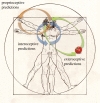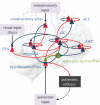Active interoceptive inference and the emotional brain
- PMID: 28080966
- PMCID: PMC5062097
- DOI: 10.1098/rstb.2016.0007
Active interoceptive inference and the emotional brain
Abstract
We review a recent shift in conceptions of interoception and its relationship to hierarchical inference in the brain. The notion of interoceptive inference means that bodily states are regulated by autonomic reflexes that are enslaved by descending predictions from deep generative models of our internal and external milieu. This re-conceptualization illuminates several issues in cognitive and clinical neuroscience with implications for experiences of selfhood and emotion. We first contextualize interoception in terms of active (Bayesian) inference in the brain, highlighting its enactivist (embodied) aspects. We then consider the key role of uncertainty or precision and how this might translate into neuromodulation. We next examine the implications for understanding the functional anatomy of the emotional brain, surveying recent observations on agranular cortex. Finally, we turn to theoretical issues, namely, the role of interoception in shaping a sense of embodied self and feelings. We will draw links between physiological homoeostasis and allostasis, early cybernetic ideas of predictive control and hierarchical generative models in predictive processing. The explanatory scope of interoceptive inference ranges from explanations for autism and depression, through to consciousness. We offer a brief survey of these exciting developments.This article is part of the themed issue 'Interoception beyond homeostasis: affect, cognition and mental health'.
Keywords: cybernetics; emotion; interoception; neuromodulation; predictive coding; self.
© 2016 The Authors.
Figures




References
-
- Helmholtz H. 1866/1962 Concerning the perceptions in general. Treatise on physiological optics. III. New York, NY: Dover.
-
- Hohwy J. 2013. The predictive mind. Oxford, UK: Oxford University Press.
Publication types
MeSH terms
Grants and funding
LinkOut - more resources
Full Text Sources
Other Literature Sources

